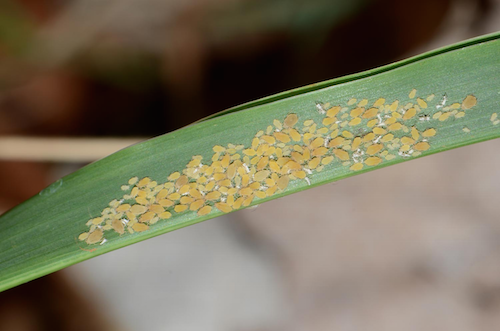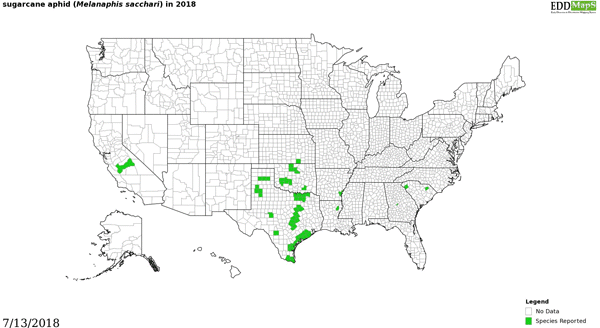During mid-to late June, three new sightings of sugarcane aphids were reported in fields in central Oklahoma—Kiowa, Caddo and Grady counties. While the numbers reported to the Early Detection and Distribution Mapping System were small, it’s time to brush up on scouting techniques, threshold numbers and treatment options.
Kansas
Kansas State University Extension officials say in their literature that sorghum plants in the state are most at risk from the boot stage onward. This is made challenging because SCA can overwinter on Johnson grass and old sorghum stubble.
To scout, go once a week. Walk 25 feet into the field and examine plants along 50 feet of a row. When scouting be aware of the following:
• If honeydew is present, look for SCA on the underside of a leaf above the honeydew.
• Inspect the underside of leaves from the upper and lower canopy from 15 to 20 plants per location.
• Sample each side of the field as well as sites near Johnson grass and tall mutant plants.
• Check at least four locations per field for a total of 60 to 80 plants.
• If no SCA are present, or only a few wingless/winged aphids are on upper leaves, repeat this sampling method once a week thereafter.
If SCA are found on lower or mid-canopy leaves, begin twice-a-week scouting. Use the same sampling method, but be sure to include the percent of plants with honeydew. Estimate the percentage of infested plants with large amounts of SCA honeydew (shiny, sticky substance on leaf surface) to help time foliar insecticides for SCA control on sorghum.
Thresholds for plants in Kansas depend on growth stage. In pre-boot and boot stages, it’s 20 percent of plants infested with localized areas of heavy honeydew and established aphid colonies. At soft dough and dough stages that number reaches 30 percent. Finally at the black layer, if there’s heavy honey dew and established aphid colonies in head—only treat to prevent harvest problems—and observe pre-harvest intervals.
More information can be found at www.myfields.info/sugarcane-aphid-kansas-sorghum.
Oklahoma
In Oklahoma, SCA will typically infest grain sorghum at pre-boot through grain fill and even into harvest. Management is typically achieved with foliar applied insecticides but have to be applied at the right time and threshold.
Oklahoma State University Extension personnel suggest the following scouting methods.
• Inspect fields weekly.
• First indication of sugarcane aphid infestations is the presence of honeydew on the upper surface of leaves, which makes the leaf look shiny. Check the underside of the leaf just above for presence of aphids.
• Once sugarcane aphid is detected in a field, inspect the field twice per week.
Sign up for HPJ Insights
Our weekly newsletter delivers the latest news straight to your inbox including breaking news, our exclusive columns and much more.
Treatment thresholds are as follows. Before panicle emergence, 20 percent plants infested with 50 or more aphids per leaf. After panicle emergence, 30 percent of plants infested with 50 or more aphids per leaf.
Chemical control in Oklahoma has been achieved by using Sivanto Prime: 4 to 7 ounces per acre or Transform WG: 0.75 to 1.5 ounces per acre. Be sure to read all instructions on the label for application spray volumes, minimum interval between applications, pre-harvest interval, pollinator protection restrictions.
For more specific information for Oklahoma sorghum, visit www.myfields.info/management-guide/sugarcane-aphid-oklahoma-sorghum.
Texas
Timing and location are the most important for Texas sorghum growers when it comes to sugarcane aphids. According to the Texas A&M AgriLife Extension Service, SCA can infest grain and forage sorghum from the pre-boot stage through flowering, grain fill and harvest. For foliar applied insecticides to be effective they need to be applied when SCA numbers are low.
When insecticide treatment is warranted because of threshold levels, consider these recommendations from the AgriLife Extension Service.
For the Texas High Plains, once SCA are found in a field, assess the infestation by walking 25 feet into the field and examine the underside of the green leaves from the lower canopy to the upper most lave for aphids. Watch for indicators of honeydew.
• Record the number of plants infested with any aphids. Also, record the number of uninfested plants.
• Examine a minimum of 10 plants at four locations across the field. Calculate the percentage of plants infested (divide the number of plants with any aphids by the total number of plants examined and multiply by 100).
• If grain sorghum is in the boot or flowering-milk stage, estimate the number of aphids per leaf. At these stages, it is critical to treat before aphid numbers exceed 100 per leaf.
In south and central Texas, when sorghum is in the pre-boot to bloom stages insecticide application can be applied when the field average reaches the range of 50 to 125 aphids per leaf. Consider treatment at 50 aphids per leaf if limited to once a week scouting or if the weather is warm and dry. Apply within four days and re-evaluate control in three days. Continue to monitor infestations until harvest to determine if a second insecticide application is needed. Infestations during grain fill can reduce harvest efficiency due to honeydew contamination and can result in stalk lodging.
As for which insecticide to use, consider what’s most effective in your area. For a complete suggestion list visit www.myfields.info/sugarcane-aphid-texas-sorghum-0 and look for the “chemical control” section. For more information, visit http://www.sorghumcheckoff.com/newsroom/2016/03/28/sugarcane-aphid.
Kylene Scott can be reached at [email protected] or 620-227-1804.




